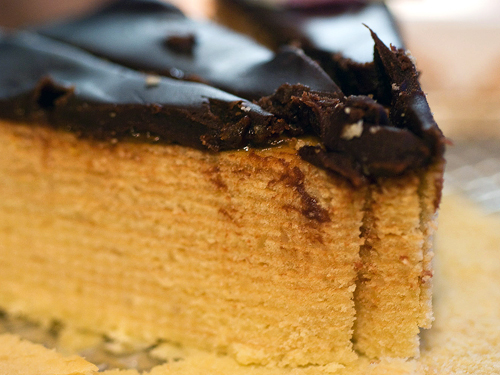One night last week, I sat at home wondering about wedding presents. It was the night before two of my friends were to be married at City Hall and I had no good ideas. The wedding was to be minimal and casual (both the bride and groom are from Germany and they are planning to have a more elaborate celebration back home later on), so good ol’ standbys like blenders and fancy plates just seemed wrong. In fact, the “reception” would just be a bunch of friends drinking at a bar, so imagine how out-of-place a gift of say, a giant silver serving platter would have been. Then suddenly, a brilliant idea!! I will bake them a cake!
Off I go, then, to search for some sort of German wedding cake recipe on the internet and that’s how I came upon Baumkuchen or to us Americans, “Tree Cake”. Apparently known as the “King of Cakes” (not to be confused with King Cake), this multi-layered cake is usually baked on this crazy, spit-like contraption that some professional bakeries have that result in a cylindrical cake with rings in it like a tree. While I might be an engineer, I’m also not about to fashion a spit in my kitchen and risk personal (and Nathan-al) injury. So thank goodness there’s a revised version where the layers are built vertically in a cake pan – even someone as clumsy as me can manage that!
This cake was so delicious and so much fun to make that I’m sure I’ll do it again sometime, for another special occasion. Except, next time, I won’t underestimate the amount of time this recipe takes and will start before 11pm. That is, unless I’m mentally prepared to stay up until 2am again.
There are a few different Baumkuchen recipes out there and if you google around, you’ll surely come upon them. I settled on combining this one and this one and was pretty happy with the result. The only thing I might try next time is possibly add in some layers of apricot jam while building the cake. And be forewarned: this recipe requires a lot of quality time in front of a toasty broiler so it might be best avoided on a sweltering summer day.










17 Comments
Hi Angi,
This looks absolutely fab, I’ve never come across this type of cake before and I must say it looks very interesting both to eat and to make.
I do know about starting out way too late in the evening, though, so thanks for the tip on planning well ahead.
And Happy International Women’s Day,
Caramella
Thanks Caramella! And yes, I highly recommend trying out this cake – even though it is a bit time-consuming, I thought it was super fun to make. Let me know how it goes! And happy International Women’s Day to you too!
This cake sounds delicious…try it soon…M gonna get ingredients from http://www.myethnicworld.com and prepare it..thanks for sharing.
Wow! I’m seriously impressed that you made a baumkuchen! I love the rings in your photo!
Hi Angi,
I’ve just made this wonderful cake – it’s cooling now and I’m struggling to keep my hubby away from it.
I couldn’t spot an email address on your blog, to ask you if you would mind if I put your recipe on my blog? In metric though :-)
You are absolutely right! It does look like the rings of a tree and tastes wonderful. The effect and presentation of this cake when baked on “…this crazy, spit-like contraption that some professional bakeries have that result in a cylindrical cake with rings in it like a tree.” is almost as much fun as the eating.
My wife and I still recall our delight in eating this cake more than 40 years ago while stationed in Japan. There was/is a large German population in and near Tokyo and Yokohama and they maintained their food culture and traditions.
Some bakeries would have an oven with the “log” spit in the window and the cake as baked while customers watched.
Thanks for the memories. Richard
Hi Richard,
That’s so neat that the cake was so popular in Japan — I had no idea! I would sure love to see the cake being made on the spit though.
Thanks for dropping in!
angi
for the recipe, what do you mean by 1 cup?
Hi Sarah,
A lot of recipes use volume measures even though it doesn’t really make sense for things like flour. According to this website, 1 cup of sifted, all-purpose flour should be equal to about 4 oz (115 grams).
Hope this helps!
angi
Hey Angi,
I recently watched a japanese cartoon about baking and they made a baum kuchen! there is even a small part about how to make it on the stove with a rectangle fry pan and a 1/2″ thick rod made of foil. Here is a link to the cartoon, scroll to the second video (it is split in two parts) the visual is 4:05 min into the video
http://www.zomganime.com/yumeiro-patissiere-episode-22/
I tomorrow I am planning on attempting this cake!!
~Heather
Hi Heather,
Thanks for the video! That’s a brilliant method to build the cake… with the rings and all and minus a crazy, dangerous, spit-like contraption! Now I really want to try it again. :)
Have fun making your baumkuchen and let me know how it turns out!
angi
Hi! Thank you so much for publishing a unique technique to make a baumkuchen. I was wondering, do you just keep layering the batter over the cooked portion of the cake? Won’t it be uneven?
Thanks for commenting, Esther! Yes, that’s how you do the layers, you’re basically cooking each thin layer of batter on top of the stack of already cooked ones. You do come out with slightly uneven layers at the end, depending on how evenly you spread the layers, but since each is so thin, it’s hardly noticeable. Besides, uneven layers means it was made with love, right? ^_^
Yes I agree! :) and please let me know if the method from yumeiro patissiere works out! That is what actually inspired me to to try to make this cake hahah ><
I’ll definitely post an update to this post if I get a chance to make the cake again with the yumerio patissiere method! :)
Hi, is it possible to get a german translation of this text? Thanks.
Hi Toni, Unfortunately I don’t speak German so I can’t provide one myself. I’m not sure how accurate it will be but it might be worth trying Google Translate: http://translate.google.com/#en|de|. Thanks for visiting!
One Trackback
[…] Go to the author’s original blog: Baumkuchen (German Tree Cake) « rice and wheat […]